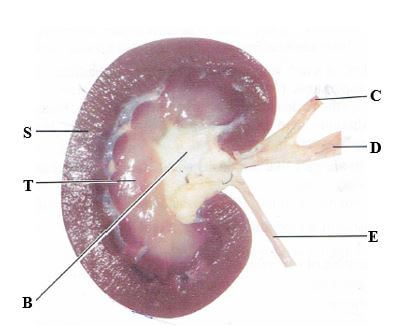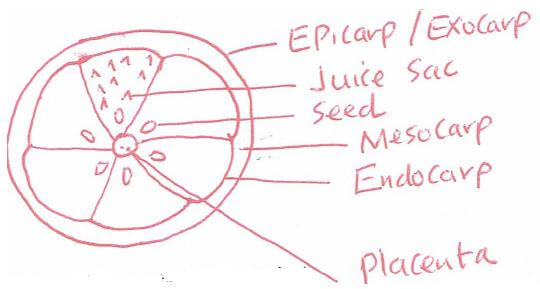INSTRUCTIONS TO CANDIDATES
- Answer ALL the questions in the spaces provided
FOR EXAMINERS USE ONLY
|
QUESTION |
MAXIMUM SCORE |
CANDIDATES SCORE |
|
1 |
19 |
|
|
2 |
12 |
|
|
3 |
9 |
|
|
TOTAL |
40 |

QUESTIONS
- You are provided with specimen A
- Name the fruit type that the specimen belongs to (1mark)
- Give a reason (1mark)
- Make a transverse section on specimen A and label the parts. (4marks)
- State the type of placentation of fruit A (1mark)
- Squeeze out the juice from the two halves of specimen A into a small beaker. Using part of the juice and the reagents provided only, test for the food substances in the juice. (6marks)
Reagent
Procedure
Observation
Conclusion
DCPIP
Benedict’s Solution
- Transfer 5ml of lime water in to a test tube. Insert a straw in the lime water in the test tube and blow air in it.
- State the observation made (1mark)
- What was the aim of the experiment? (1mark)
- Account for the observation (2marks)
- What biological process produces the gas being tested in this experiment (1mark)
- What physiological process is involved in the removal of the gas from the body. (1mark)
2. The photograph below shows a section of a mammalian kidney and associated vessels. Examine it and answer the questions that follow.

- To what plane has the section been made (1mark)
- Name the parts B, C, D and E (4 marks)
B .................................................
C .................................................
D .................................................
E ................................................. - State any two functions of the kidney (2marks)
- Name the part of the nephron found in the structure labelled S (1mark)
-
- State the two hormones whose target part is T (2marks)
- State the roles of the hormones named in question 2 e) (i) above (2 marks)
3. The photographs below represent twigs from various plant species. Study them and answer the questions that follow

- Complete the dichotomous key below using observable features (1mk)
-
- Twigs with simple leaves . go to 2
- Twigs with compound leaves go to 5
-
- Leaves with parallel venation. go to 3
- Leaves with network venation ...go to 4
-
- leaves purple Tradescantia
- Kikuyu grass
-
- Leaves with opposite arrangement...Verbenaceae
- Leaves with alternate arrangement .Hibiscus
-
- Leaves trifoliate.... go to 6
- Leaves not trifoliate go to 7
-
- Leaves with serrated margin Bidens pilosa
- Leaves with lobed margin. Oxalis
-
- leaves pinnate go to 8
- leaves bipinnate . ..Acacia
-
- Leaflets with rounded apexPapilionaceae
- Leaflets with pointed apex. Rose
-
- Using the completed dichotomous key identify the twigs and show the steps followed (6mks)
Steps followed Identity
P ............................... ............................................................
Q ............................... ............................................................
T ............................... ............................................................ - With a reason, identify the class to which specimen S belongs. (2mks)

MARKING SCHEME
-
- You are provided with specimen A
- Name the fruit type that the specimen belongs to (1mark)
- Berry;
- Give a reason (1mark)
- It has two scars;
- Make a transverse section on specimen A and label the parts. (4marks)

- State the type of placentation of fruit A (1mark)
- Axile; / Central placentation; Rej. Axial;
- Name the fruit type that the specimen belongs to (1mark)
- Squeeze out the juice from the two halves of specimen A into a small beaker. Using part of the juice and the reagents provided only, test for the food substances in the juice. (6marks)
Reagent
Procedure
Observation
Conclusion
DCPIP
To 2ml of DCPIP, add the juice dropwise and shake;
DCPIP is decolourised;
Vitamin C present; (Ascorbic acid present);
Rej; presence;
Benedict’s Solution
To 2ml of the juice, add 2mls of Benedict’s solution, shake to mix and heat to boil;
Colour changes from blue/yellow/ orange/ brown;
Reducing sugar present;
- Transfer 5ml of lime water in to a test tube. Insert a straw in the lime water in the test tube and blow air in it.
- State the observation made (1mark)
- White precipitate observed in the test tube;
- What was the aim of the experiment? (1mark)
- To investigate the gas produced during expiration;
- Account for the observation (2marks)
- Carbon IV oxide produced during expiration; reacted with lime water;
- What biological process produces the gas being tested in this experiment (1mark)
- Respiration;
- What physiological process is involved in the removal of the gas from the body. (1mark)
- Diffusion;
- State the observation made (1mark)
- You are provided with specimen A
- The photograph below shows a section of a mammalian kidney and associated vessels. Examine it and answer the questions that follow.

- To what plane has the section been made (1mark)
- Longitudinal;
- Name the parts B, C, D and E (4 marks)
- B Pelvis;
- C Renal artery;
- D Renal vein;
- E Ureter;
- State any two functions of the kidney (2marks)
- Ionic balance; Osmoregulation; Excretion; (any two)
- Name the part of the nephron found in the structure labelled S (1mark)
- Bowman’s capsule; Proximal convoluted tubule; Glomerulus; Distal convoluted tubule;(any one)
-
- State the two hormones whose target part is T (2marks)
- Antidiuretic hormone (Vasopressin); Aldosterone;
- State the roles of the hormones named in question 2 e) (i) above (2marks)
- Antidiuretic hormone (Vasopressin); increases the permeability of the tubule to water;
- Aldosterone hormone; reabsorption of mineral ions at the Loop of Henle
- State the two hormones whose target part is T (2marks)
- To what plane has the section been made (1mark)
- The photographs below represent twigs from various plant species. Study them and answer the questions that follow

- Complete the dichotomous key below using observable features (1mark)
1(a) Twigs with simple leaves …………………………………………………. go to 2
(b) Twigs with compound leaves…………………………………………… go to 5
2(a) Leaves with parallel venation…………………………………………. go to 3
(b) Leaves with network venation ………………………………………. go to 4
3(a) Leaves purple……………………………………………………… Tradescantia
(b) Leaves green;……………………………………………… Kikuyu grass
4(a) Leaves with opposite arrangement………………………………… Verbenaceae
(b)Leaves with alternate arrangement ………………………………… Hibiscus
5(a) Leaves trifoliate………………………………………………………….... go to 6
(b) Leaves not trifoliate……………………………………………………… go to 7
6(a) Leaves with serrated margin……………………………………… Bidens pilosa
(b) Leaves with lobed margin………………………………………………. Oxalis
7(a) Leaves pinnate ……………………………………………………………go to 8
(b) Leaves bipinnate ……………………………………………………… Acacia
8(a) Leaflets with rounded apex…………………………………………Papilionaceae
(b) Leaflets with pointed apex……………………………………………. Rose - Using the completed dichotomous key identify the twigs and show the steps followed (6marks)
Steps followed Identity- P 1b,5a,6a Bidens pilosa
- Q 1a,2b,4b Hibiscus
- T 1b,5b,7a,8a Papilionaceae
- With a reason, identify the class to which specimen S belongs. (2marks)
- Monocotyledonae; parallel venation;
- Complete the dichotomous key below using observable features (1mark)

CONFIDENTIAL
Provide every candidate with the following:
- A full orange fruit labelled A
- A means of cutting (Should be a sharp knife or Scalpel)
- Hand lens
- 3 test tubes in a beaker
- 50ml beaker
- Straw
- A beaker containing some lime water labelled
- A boiling tube
- A source of heat or hot water bath
- A test tube containing about 2ml of DCPIP
- Let every student access Benedict’s solution with a dropper.
Download Biology Paper 3 Questions and Answers - Asumbi Girls Pre Mock Examinations 2023.
Tap Here to Download for 50/-
Get on WhatsApp for 50/-
Why download?
- ✔ To read offline at any time.
- ✔ To Print at your convenience
- ✔ Share Easily with Friends / Students
